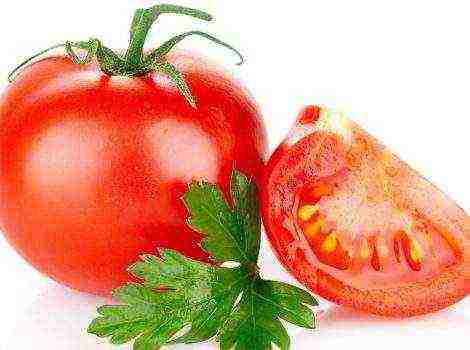Content
- 1 The best dark red beets without light rings
- 2 Varieties for the Moscow region
- 3 Varieties for the Urals
- 4 Varieties for Siberia
- 5 Bordeaux 237
- 6 Bravo
- 7 Valenta
- 8 Mona
- 9 Mulatto
- 10 Incomparable А463
- 11 Pablo F1
- 12 Rocket F1
- 13 Cylinder
- 14 Early beet varieties - spring vitamins
- 15 Mid-season varieties - universal use
- 16 Late varieties - winter stock
- 17 Which variety should you choose?
- 18 Characteristics of beet varieties with photos and descriptions
Beetroot is one of the most famous vegetables and has been known for a long time. To get a good harvest of these root crops suitable for winter storage, you need to choose the right varieties. There are quite a few varieties of beets and when choosing, you need to take into account that they are divided according to ripening times, adaptability to a particular climate, soil and other characteristics of the culture.
Only the best beets can be used to make delicious salads, soups, borscht, snacks, vinaigrette and pickles.
Beets are divided into 3 groups according to the ripening period, these are: early, middle, late.
The best dark red beets without light rings
Early varieties
Early varieties of beets allow you to feast on a variety of dishes from this delicious vegetable in the summer, immediately after harvesting. The vegetable can be consumed without heat treatment. Sowing of seeds in such varieties occurs earlier than others, and harvesting occurs in 75-110 days.
Bordeaux 237
 Bordeaux 237
Bordeaux 237
It belongs to one of the most famous cold-resistant beet varieties. Ripening of this variety occurs in 99-120 days. Fruits are medium in size, round in shape. The taste is pleasant, sweet, characteristic of this vegetable. The pulp is dark red. When frozen, taste is not lost. Beets with a long shelf life (more than six months). Suitable for sowing before winter. Not susceptible to damage by pests, diseases.
Modana
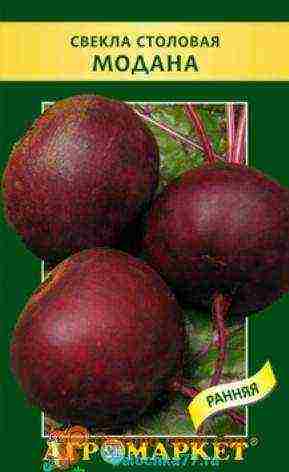 Modana variety
Modana variety
Modana red beet has a neat and beautiful round shape. A variety without light rings. The color of the variety is dark, burgundy-cherry. Weight reaches 130-260 grams. The pulp is pleasant to the taste, sweetish. Grown with seedlings. From the moment of planting young plants to harvesting, 68-85 days pass. The variety is cold-resistant, unpretentious, disease-resistant. Suitable for bundling and recycling. Not stored for long.
Pablo F1
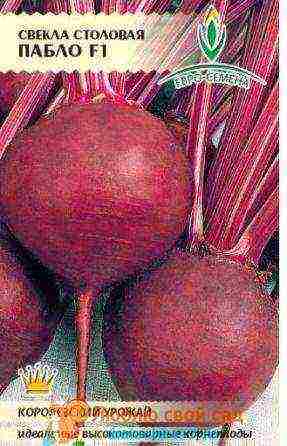 Pablo variety
Pablo variety
Early ripe, sweet variety. The fruits are round in shape. The size is the same. Weight 195-380 grams. The skin is thin. Root crop without light rings. The pulp is rich in color, dark red. Fruit collection is uneven, starting from 85-95 days. The variety is stable, it is stored for several months.Dark varieties of beets are ideal for making vinaigrette.
Bohemia
Bohemian variety
Refers to dark varieties of beets. The shape is round. The color is even, dark burgundy. A variety without light rings. The taste is sweet, delicate and very juicy. Root crops ripen in 77-83 days. Beets of this variety are resistant to diseases and are well stored. Does not lose its appearance, taste during storage.
Detroit
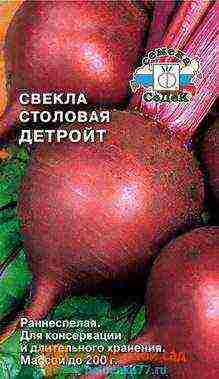 Detroit variety
Detroit variety
Cold-resistant, early ripening variety. It does not freeze during spring frosts. The plant, during active growth, is demanding for watering. Red beets without light rings. The fruits are small and small. Weight reaches 210 grams.
The shape is neat and round. The harvest is massive, begins on the 105-110th day. The variety is not susceptible to disease. When feeding, the size of the fruit increases.
Boltardi
 Boltardi variety
Boltardi variety
An early, high-yielding, cold-resistant variety. Root crops are frost-resistant. The pulp is juicy, tasty, dark red in color. Radial rings are visible on the cut. Average weight 160 grams. Fruits are smooth, neat, rounded.
The variety is well stored, not afraid of frost, resistant to most diseases. When sowing under cover in spring, it is suitable for bunch harvesting. With late sowing, the harvested crop can be stored for the winter for 3-5 months.
Egyptian flat
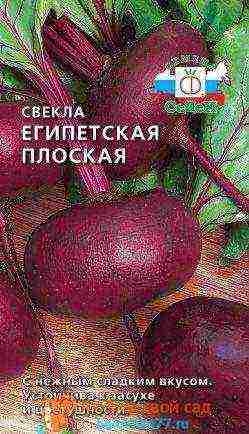 Grade Egyptian flat
Grade Egyptian flat
It is famous for its large (more than 500 grams) fruits. The pulp is purple-burgundy. Small radial circles are visible. The taste is sweet, juicy, ideal for vinaigrette. Ripening in the Egyptian flat variety occurs in 90-100 days. The variety is drought-resistant, stored for more than six months.
Mona variety
 Mona variety
Mona variety
One-sprout, grown from seedlings. Cylindrical beets. Weight reaches 300 grams. Harvesting is done in 105-115 days. Beets of this variety are suitable for bundling and processing.
Medium varieties
These varieties easily tolerate sowing for the winter. Summer drought does not harm fruit formation. Shelf life is longer than that of earlier varieties. Mid-season varieties are divided into several types and when choosing seeds, all the characteristics of the variety must be taken into account.
Borsch
 Variety Borshchivaya
Variety Borshchivaya
Borscht beet is suitable for growing on any soil. The pulp is pleasant to the taste, soft, dark raspberry color. No light rings. Small white radial circles sometimes appear. Fruits are of the same size, small. Fruit weight 230-500 grams. The skin is thin. Ripen in 98-104 days.
With good feeding, up to 9 kilograms of fruit are removed from a square meter. Can be sown in summer and before winter. Suitable for preparing vegetable juices, first courses, snacks, salads.
Delicacy
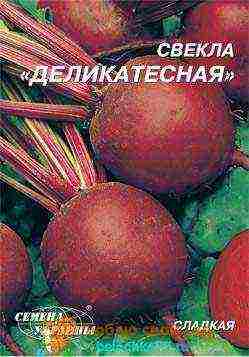 Delicacy variety
Delicacy variety
Delicacy beets are versatile and cold-resistant varieties. Fruits of the Delikatesnaya variety are used for cooking, preparing various dishes, preparations, and fresh consumption.
Maturation occurs on day 95. Small beets. The shape is round. The skin is smooth, thin. Beets are dark varieties and have dark cherry flesh. There are no radial rings.
With growth, several shoots begin to bloom, this practically does not affect the yield. The vegetable is stored for a long time. Versatile to use. The variety is suitable for central Russia, grows well in cool weather.
Opolskaya
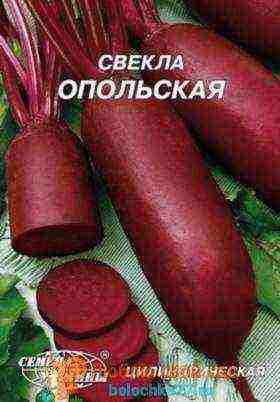 Beetroot Opolskaya
Beetroot Opolskaya
Mid-season, moisture-loving variety. The shape of the fruit is oblong. The skin is thin. The taste is slightly sweet. Thin rings are visible on the cut. At the beginning of growth, the variety is demanding for timely, abundant watering. Shelf life up to six months. The commercial quality and taste do not change during storage.
Incomparable А 463
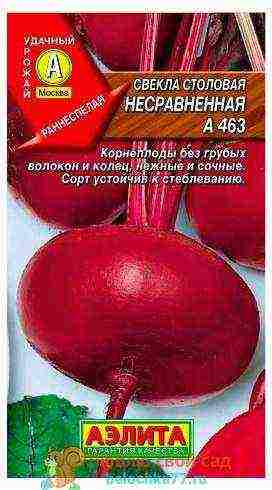 Grade Incomparable А 463
Grade Incomparable А 463
It is a high-yielding, unpretentious beet variety. The fruits are large, flat-round in shape. The top is red-gray. The pulp is dark cherry, tasty, juicy. A variety without light rings. Up to 9 kilograms of fruit can be removed from a square meter.
The crop easily tolerates wintering, does not lose its qualities. The growing season lasts 100 days. Beets of this variety are not damaged by pests or diseases.
Mulatto
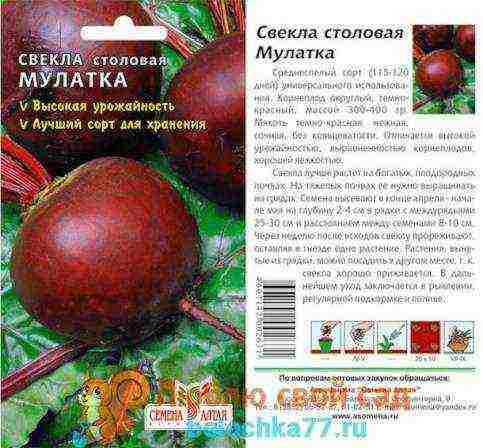 Variety Mulatka
Variety Mulatka
Differs in tasty and large fruits. Spherical beets. Weight reaches 500 grams. The pulp is uniform red, without light rings, soft, tasty. The color does not change during cooking. The harvest is stored throughout the winter.
Harvesting is done 115-120 days after sowing. Up to 7.5 kilograms of fruit are removed from one meter. Early plantings can be sold in bunches.
Cold resistant 19
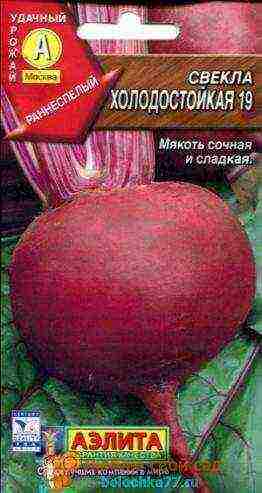 Cold-resistant grade 19
Cold-resistant grade 19
Cold hardy, medium early variety. The technical ripeness of root crops occurs in 65-76 days. The shape is flattened round. The color of the beets is dark red. The skin is smooth. Weight 150 - 230 grams. The pulp is very tasty, juicy, tender. The variety is suitable for bunch cultivation. The keeping quality of the fruit is good. You can sow in spring and before winter.
Noblewoman
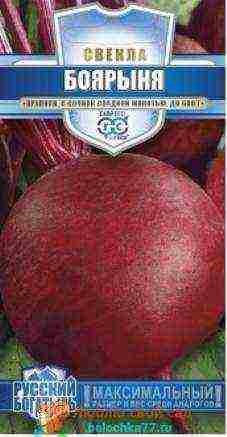 Variety Boyarynya
Variety Boyarynya
High-yielding and mid-season variety. The root crop is spherical. Weight 210-350 grams. With timely feeding, it increases.
Late varieties
These varieties have a long growing period. They are resistant to frost in spring and autumn and heat in summer. Vegetables are stored in a cool place until the next harvest. The loss of weight and appearance is negligible.
Renova
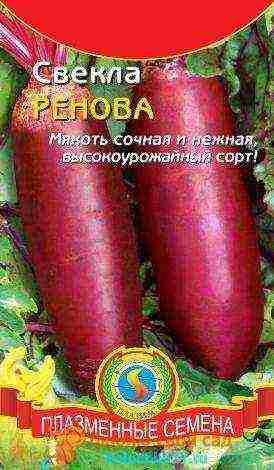 Renova variety
Renova variety
Renova beets are famous for their bountiful harvest. The shape is cylindrical. The skin is thin, dark pink. The pulp is reddish-purple. The fruit does not have a beetroot smell. The taste is pleasant. Fruit weight reaches 390 grams. The variety is cold-resistant and undemanding to the climate and growing conditions.
One-sprout
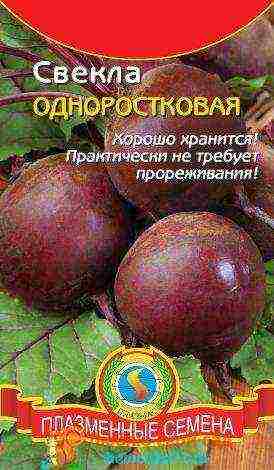 Single-sprout variety
Single-sprout variety
The single-sprout variety, with good care, allows you to remove up to a ton of root crops from a hundred square meters of land. From the moment of seed germination to full maturity of the fruit, 130 days pass. In a cool place, the vegetable is stored for up to six months. Average weight 450-550 grams.
The taste is pleasant, juicy. The pulp is dark burgundy. The skin is thin. The shape is flat-round. You can use cassettes for growing seedlings. The variety is not susceptible to disease.
Cylinder
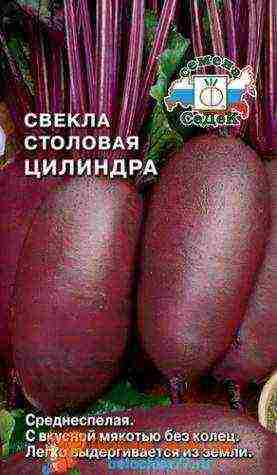 Cylindra grade
Cylindra grade
Cylinder red beet got its name from its cylindrical shape. The plant is cold and heat resistant. Ripens in 101-120 days. Up to 120 kilograms of fruit are collected from a hundred. The size of the roots is small. But with good care it reaches 700 grams. Length 25-32 centimeters.
The taste is pleasant, juicy, odorless. The color is bright, without light rings. The skin is thin. The harvested crop is stored for up to 9 months. Diseases, pests, frost and heat are not terrible for this variety.
Matron Zedek
 Matrona Sedek variety
Matrona Sedek variety
It is a late variety. Beets are dark varieties. Rings are weak. The shape of the fruit is flat-round. Weight reaches 300 grams. The taste is pronounced. The fruits are suitable for long-term storage, do not lose their qualities.
Citadella
 Citadella variety
Citadella variety
Red beet Citadela is a late-ripening variety. Average length. The shape is cylindrical. The pulp is bright, without light rings. The taste is beetroot. If stored properly, it lasts until May. The appearance and taste practically does not change.
You can also distinguish varieties: Belushi F1, Vinaigrette, Red Ruby, Bikores, Wodan F1, Two-seeded TSKHA, Bolivar, Crimson ball, Nohovski, Queen F1, Cold-resistant, Bettollo F1, Bona, Bordeaux single-seeded, Globus, Boro F1, Zhukovchanka, Libero, Subeto F1, Madam, Ideal, Demeter. They are distinguished by excellent taste and versatility in use.
Varieties for the Moscow region
For central Russia, you can choose quite a few varieties of beets, which, with proper care, give an excellent harvest of high-quality root crops.
Early varieties for the Moscow region include: Red ball, Wodan, Detroit, Pushkinskaya flat, Bordeaux-237, Boltardiran, Gribovskaya flat, Mulatka, Slavyanka. Beets of these varieties ripen in 2.5-3.5 months.
Red ball
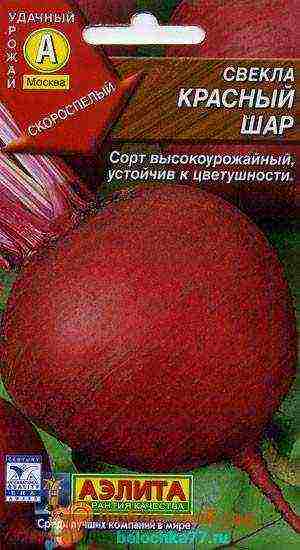 Variety Red ball
Variety Red ball
An early, dietetic variety. Sowing is done in early spring. Harvesting begins in 68-72 days. Root weight 150-250 grams. The pulp is very juicy, dark red. Cut rings are weak. 3-6 kilograms of root crops are removed from a square meter.
Wodan F1
 Variety Wodan F1
Variety Wodan F1
An early, high-yielding hybrid variety. The hybrid ripens in 78-82 days. The shape is round, smooth, the tail is thin. The color is dark red, without light rings. Root weight 220-500 grams. The taste is pronounced, juicy.
The best medium varieties: Eclipse, Bohemia, Egyptian flat, Donskaya flat, A-463, Bona, Cold-resistant-19, Matrona, Monocle, Patrick. Root crops are resistant to cold and drought. Stored well.
Eclipse variety
Mid-season. Beets have an elongated oval-cylindrical shape with a blunt, round or slightly curved shape. The pulp is red-violet, tender, juicy.
Late varieties include: Ataman, Podzimnyaya, Cylindra, Bordeaux single-seeded, Renova, Rocket, Bettina, Larka. The seeds of these varieties should be sown in late spring.
Variety Ataman
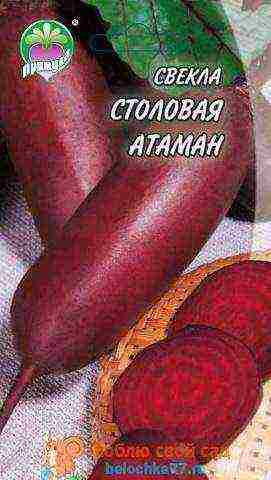 Variety Ataman
Variety Ataman
Medium late, ideal for the Moscow region. Easily tolerates frost, does not like dampness. Maturation occurs at 120-130 days. The shape is cylindrical. Fruit weight 200-300 grams. The color of the root crop is dark red. The pulp is tender and juicy without light rings. The taste is excellent. The variety is lazy.
The pulp of these varieties is tender and juicy. The fruits are not intended for long-term storage.
Varieties for the Urals
For the Urals, the best varieties are: Bikores, Valenta, Bon-Bon F1, Odnorostkovaya, Bravo, Crimson ball, Betina, Detroit 2, Boltardi, Scarlett suprim, Gribovskaya flat A-473, Bordeaux single-seeded, Bordeaux 237, Bona, Mulatka, Virovskaya single-seeded , Crimson Globe, Incomparable A-463, Podzimnyaya A-474, Rougette F1, Dark red round, Chrobry (Brave), Cold-resistant 19, Cylinder.
Dark variety One-sprout - early maturing and fruitful. The vegetative period is 80-130 days. A distinctive feature of the variety is one and two-seeded fruits. The shape is rounded flat or round. Weight 300-600 grams. The color is rich, dark burgundy. The pulp is tasty, juicy and tender. Stored for a long time.
Bikores
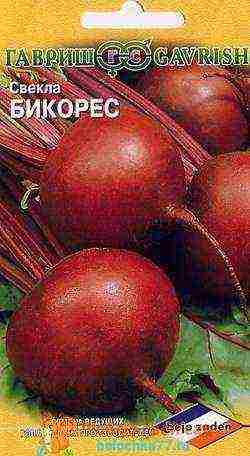 Variety Bikores
Variety Bikores
is a fruitful, mid-season beet variety. Sweet variety. The color of the fruit is maroon. The shape is round, leveled. Weight 210-350 grams. The pulp is bright, without light rings, tasty, juicy. About 6 kilograms of fruits are harvested from a square meter.
Valenta variety
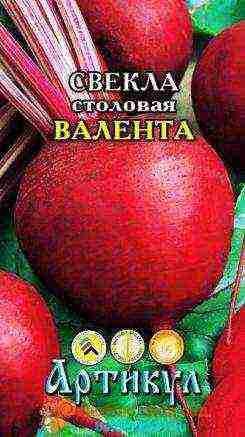 Valenta variety
Valenta variety
One-germ, grows in 95-100 days. Weight reaches 300 grams. The shape is oval-rounded. The pulp is sweet, tasty, dark red. The variety is dormant, cold-resistant, not afraid of diseases.
Bon-Bon F1
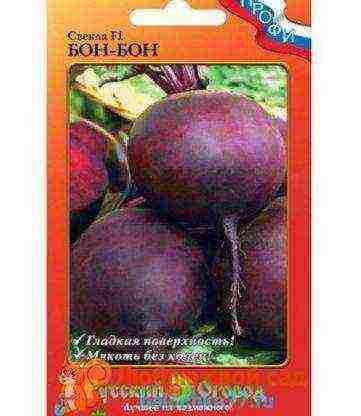 Variety Bon-Bon F1
Variety Bon-Bon F1
This is a medium-ripening beet variety. The growing season is 120 days. The flesh of the fruits is bright red, without light rings, tasty. The shape is round, with a thin skin. Sowing is carried out from April to mid-July.
These varieties easily tolerate sudden temperature changes and cool climates. With good care, the harvest is very abundant.
Harvesting is stretched until the end of September. For spring planting at the beginning of growth, it is recommended to use a covering material.
Varieties for Siberia
The most suitable varieties for the Siberian climate are: Siberian flat, Podzimnyaya, Red ice, Mashenka, Krasny bogatyr, Odnorostkovaya, Incomparable, Bordeaux 327, Cold-resistant, Pablo, Cylinder.
Siberian Flat Beet
An early variety, ripens in 98-100 days. The shape is flat. Beets are dark and reddish-purple in color. Weight 200-400 grams. The taste is excellent. The variety is cold-resistant, disease-resistant.
Winter
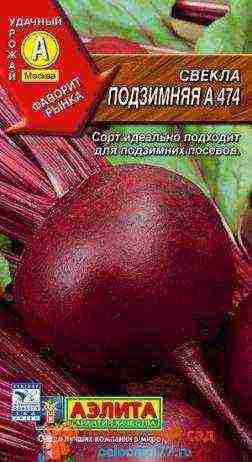 Podzimnyaya variety
Podzimnyaya variety
Medium early grade. The shape is round. Weight 200-400 grams. The color of the pulp is burgundy. The variety is cold-resistant, resistant to most diseases.
Red ice grade
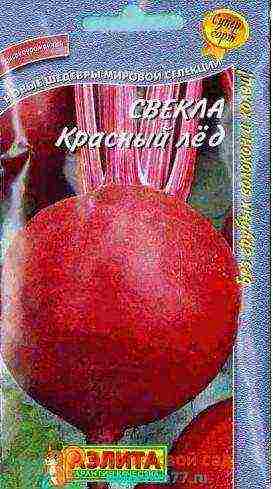 Red ice grade
Red ice grade
Ripens in 100 days. The pulp is bright, with small rings. The weight of the root crops is 200–300 grams. 4-5.5 kilograms of beets are harvested from a square meter.
Red hero
High-yielding variety. The shape is cylindrical. The skin is thin, dark red. Pulp without rings. Weight 200-550 grams. Productivity from a square 8-10 kilograms.
Masha
 Variety Mashenka
Variety Mashenka
Mid-season and high-yielding variety. Dark red variety without light rings.The shape is cylindrical, smooth. Up to 9 kilograms of fruits are harvested from a meter. Fruit weight 310-600 grams. The fruits are delicious. The plant is not susceptible to disease.
Growing beetroot seedlings can increase the likelihood of a good harvest. The best option for planting is the cassette method. With this planting, 1 plant grows in a separate cell and planting and thinning is not required.
Under favorable conditions, an excellent harvest can be harvested by September - early October.
Quite often, in these regions, sowing is used before winter, when the ground is frozen, the seeds are placed in the beds, and in the spring, when the soil warms up, they quickly begin to grow.
Sweet varieties for central Russia, Moscow region, Siberia: a hybrid of Pablo, Detroit round, Incomparable, Cylinder.
Some of the most widely used and loved by gardeners varieties of the Urals and Siberia are: Red Ice, Bikores, Siberian flat, Mulatka, Krasny Bogatyr, Mondoro F1, Mashenka, Vital cylinder.
Dark varieties of beets are in great demand, suitable for the preparation of various snacks, juices, first and second courses, salads, preparations.
All these varieties, with proper agrotechnical work, give an excellent yield of high-quality fruits.
Sugar beet varieties and hybrids differ in many ways. But among them there are absolute leaders, bred as a result of many years of selection. Now you will learn about nine of the best beet varieties based on a combination of traits.
First of all, table beets should be tasty, safe for health and have a long shelf life. Many gardeners believe that the entire set of these qualities can only be found in varieties of foreign selection. Indeed - imported root crops are smooth and beautiful, consistently pleasing with a high yield. But even among the domestic varieties, you can find sweet and spicy varieties. We will tell you about the best of the best representatives of the beetroot world.
Bordeaux 237
This variety was bred by Soviet breeders in 1943. This is one of the most popular and studied mid-season varieties. The plant is thermophilic and demanding on lighting, but at the same time it is distinguished by drought resistance. Root crops are round and flat-rounded, with delicate flesh of a thick burgundy color. The sugar content is high, while the beets are stored for a long time without losing their taste. The variety is resistant to diseases, occasionally affected by cercosporosis and peronosporosis.
| Appointment | Root diameter (cm) | Beet weight (g) | The period from germination to technical ripeness (days) |
Yield (kg / sq.m) |
|
|
12-15 |
260-500 |
60-110 |
4-8 |
||
Bravo
One of the most productive, unpretentious, tasty and mature varieties. It can be grown all over the area from Moldova to the Ural Mountains. Root crops are round, smooth, dark red, with a small head. The pulp is light burgundy, without ringiness, dense and juicy. Up to 98% of the sown seeds emerge. A plant below average is affected by cercospora and beet flea.
| Appointment | Root diameter (cm) | Beet weight (g) | The period from germination to technical ripeness (days) |
Yield (kg / sq.m) |
|
|
13-16 |
250-680 |
70-100 |
3-7 |
||
Valenta
Mid-season high-yielding variety. The roots are dark red, smooth and clean. The pulp is juicy and tender, with faint rings. A ripe root crop is easily pulled out of the soil. The taste is memorable, dessert. Beets contain a large amount of B and PP vitamins. The plant withstands extreme cold, but responds to lower temperatures by lowering yields. The harvested crop can be stored for a long time without fear of loss of presentation.
| Appointment | Root diameter (cm) | Beet weight (g) | The period from germination to technical ripeness (days) |
Yield (kg / sq.m) |
|
|
12-15 |
175-330 |
90-120 |
4-8 |
||
Mona
Medium early single-sprout variety. Root crops are cylindrical, red in color with a dark color. The pulp is dark red, juicy and melts in the mouth. The plant does not need additional thinning during the growing period.Water the roots as needed, slightly increasing the frequency of watering during dry periods. Regular feeding and loosening should be carried out and then the plant will not be afraid of diseases.
| Appointment | Root diameter (cm) | Beet weight (g) | The period from germination to technical ripeness (days) |
Yield (kg / sq.m) |
|
|
10-13 |
200-330 |
75-100 |
5,5-7 |
||
Mulatto
Outwardly, this variety does not differ much from the usual table varieties of beets. Root crops are of the correct round shape, as they ripen, they change color to maroon. Gardeners appreciate the pulp for its amazing taste and the absence of rings. The yield of the variety is quite high and practically does not require additional care. Mulatto is best stored during the winter months, and the marketable yield is usually 95-98%.
| Appointment | Root diameter (cm) | Beet weight (g) | The period from germination to technical ripeness (days) |
Yield (kg / sq.m) |
|
|
10-12 |
180-360 |
125-130 |
3,5-6 |
||
Incomparable А463
It is a rare case when the properties of a product fully correspond to its name - this is really one of the best varieties. Root crops are usually flat, sometimes round-flat with a maroon skin, which turns gray closer to the outlet. Beets have a delicate flesh with a dark scarlet hue and dark rings. The variety is absolutely resistant to cercosporosis and can be stored well for several months. Great for all types of home cooking.
| Appointment | Root diameter (cm) | Beet weight (g) | The period from germination to technical ripeness (days) |
Yield (kg / sq.m) |
|
|
8-10 |
170-360 |
70-100 |
3-6 |
||
Pablo F1
This hybrid was obtained relatively recently, but has already managed to fall in love with many gardeners for its useful properties and unpretentiousness. Medium early in terms of ripening, it has an unsurpassed yield, which reaches 98-99%. All root vegetables are like siblings - they are very similar to each other, with thin skin and a small tail. The flesh on the cut is bright red, without annular divisions. Plants thrive in cold regions and can be stored throughout the winter.
| Appointment | Root diameter (cm) | Beet weight (g) | The period from germination to technical ripeness (days) |
Yield (kg / sq.m) |
|
|
10-15 |
125-450 |
60-100 |
6-7 |
||
Rocket F1
The elongated roots of this hybrid are difficult to confuse with others. It belongs to the mid-season and is used both for processing and for haute cuisine. Root crops are cylindrical, dark red, with a smooth, almost glossy surface. The color is intense and uniform. The color of the flesh approaches purple, the rings are absent. The taste is excellent. The yield and keeping quality of root crops is high.
| Appointment | Root diameter (cm) | Beet weight (g) | The period from germination to technical ripeness (days) |
Yield (kg / sq.m) |
|
|
3-5 |
250-400 |
120-125 |
5-7 |
||
Cylinder
The unusual shape of the root crop, characteristic of this variety, attracts gardeners very much. These are medium-sized plants with dark red oblong fruits and a small "waist". The variety is weakly susceptible to various kinds of diseases, therefore, yields are high. The sweet taste allows you to add beets to borsch, salads and use for preservation. There are no whitish circles in the root crop, so it is very convenient to cut the beets and add them to various dishes.
| Appointment | Root diameter (cm) | Beet weight (g) | The period from germination to technical ripeness (days) |
Yield (kg / sq.m) |
|
|
4-5 |
250-500 |
110-130 |
5-7 |
||
Sweet beets are a real decoration for any table. With her, dishes acquire a completely new taste and emphasize the skill of the chef. Anyone can grow such beets, especially if you grow one of the varieties we have described.
Where do beets come from in Russia? In the 10th century, beets were brought to Russia from Byzantium. The overseas root crop took root in the new land, became food for people and livestock, and a source of sugar. Beetroot has long been perceived by us as a primordial Russian culture. Every gardener in Russia has grown it at least once.It is quite unpretentious, it grows both in the middle lane and in the southern regions, and even for Siberia varieties that ripen in the open field have been bred. Beets are highly regarded for their taste and health benefits.
Growing beets in the open field
Beets are grown both in greenhouses and in the open field, and it is the second method that is more popular in our country. Beets are well stored, so there is no reason to grow them in the cold season, and in the warm season, open ground is quite suitable. Beets are planted either by seeds or seedlings.
Beet field - photo
Important! Beets grow on almost any soil, except for very heavy clay soils. But they remove it in different ways: on sandy and peaty soils, they pull it out by hand so as not to damage the fruit, and on heavy and wet soils they gently undermine it with a pitchfork.
In the photo, manual harvesting of beets
Comparison of different groups of beet varieties by their qualities
| Early varieties | Before winter - at the beginning of November, in the spring - at the end of April | End of June, July, beginning of August | 200-500 g | average, "for an amateur" | 2-5 months |
| Mid-season varieties | First half of May | End of August, beginning of September | 350-550 g | good or great | 5-7 months |
| Late varieties | Second half of May | Early September - late October | 400-600 g | excellent | 7-9 months |
Using different varieties of beets
| Early varieties | Bunches, raw, for cooking, for the production of juices. |
| Mid-season varieties | Raw, for cooking, juice production, vegetable preservation, for winter storage. |
| Late varieties | For winter storage, conservation. |
Early beet varieties - spring vitamins
Early beet varieties
Early beets ripen in 50–80, sometimes up to 100 days from the moment of germination and reach the table in the middle of summer. A big drawback of early varieties is their low keeping quality; such beets are not left for winter storage. Not everyone likes the taste of early beets, because during the short growing season they do not have time to accumulate as many sugars as late beets. But for consumption in late June - September, early varieties are optimal.
1) Libero
Seeds of the earliest beet Libero
One of the earliest ripening varieties of beets, good taste. Forms a root vegetable quickly, suitable for use on bunches. The fruit is medium-sized, up to 225 g, round. The skin is thin, easy to peel from both raw and boiled fruit. The pulp is dark red, with dark dull circles, tender. Looks beautiful both fresh and cooked, great for implementation. This variety is often chosen by manufacturers of early and bunched products.
Libero - beetroot
Also, borscht is cooked from Libero beets, juices are driven. Summer residents choose this variety for personal consumption in June-July, when there are almost no other root crops. You just need to remember about the obligatory thinning of the beds with roots of this variety.
2) Vinaigrette Jelly
Unlike many early varieties, the beetroot Vinaigrette Marmalade is well stored and gives very large fruits weighing up to 500 g. The skin of the fruit is rough, dull, the pulp is dense, rich red, practically without circles and pith. The fruits are tasty, round or flat-round in shape. The disadvantages of this variety include the fact that the fruits, when they grow by about half, look out of the ground and the upper part of them often grows stiff.
3) Cold resistant 19
An early maturing variety, frost-resistant. Ripens in 66-70 days, yields average-sized fruits of 200-250 g. The shape of the fruit is round and slightly flattened. The skin is smooth, dark red. The pulp is very juicy, moderately sweet, pleasant to the taste. Unfortunately, due to its juiciness, it is not stored for a long time.
4) Pablo
Beetroot Pablo
A mid-early variety, ripens in three months, sometimes it is even referred to as mid-season. Loved by farmers for extreme unpretentiousness and endurance. Bright red, even rounded fruits with a matte skin of medium thickness grow small, about 200 g.The pulp is tender, pleasant to the taste, without rings, homogeneous. This variety is popular for cultivation in the Urals as it is resistant to early frost. When grown in hot climates, it needs regular watering.
5) Bordeaux 237
The variety is medium early. Widespread in central Russia. It tolerates wintering well when sowing in late autumn, when summer sowing it is well stored (up to 5 months). It ripens for about 85-100 days and has a good yield. Heads of medium or large size, 250-500 g each, rounded, slightly flattened at the top and bottom. The pulp is dense, sugary, rich burgundy color.
Mid-season varieties - universal use
Such beets ripen within 80-110 days from sprouting to readiness for harvesting. These varieties already have the best taste and are suitable for winter storage. However, they are recommended to be planted with seedlings, which is difficult for inexperienced gardeners. There is a risk of slightly damaging the root when transferring seedlings to the ground, as a result of which additional roots are formed on it and instead of one beautiful, even root crop, a knot of several heads is formed, ugly and inconvenient for use. However, many mid-season varieties are also suitable for planting in the ground with germinated seeds. They are planted from the beginning to the twenties of May, as well as late varieties.
1) Detroit
A very popular variety grown throughout Russia, Ukraine, Moldova. It is resistant to cold so much that it can be planted in open ground in the second half of April. Forms red, rounded fruits with smooth skin. The fruits are very tasty, the dark red pulp is moderately juicy and sweet. Stores well. It is grown mainly for its taste and high yield. It is often grown for the purpose of further processing into juices and canned vegetables.
2) Borsch
A variety that differs from others in pronounced rings on the cut of the fruit. Wide dark red rings alternate with white and pink ones, forming a beautiful pattern that looks aesthetically pleasing in ready-made dishes. It takes 90-120 days from germination to technical ripeness. Forms large, very tasty fruits weighing up to 350-500 g. Stored up to 6-7 months. The downside of the variety can be called its high demand for growing conditions from the composition and moisture of the soil to the abundance of light. Under good conditions it has a high yield.
3) Incomparable A 463
A variety of beets that produces medium-sized, rounded fruits of almost the same weight and shape with a wide axial root. Excellent for cultivation with the aim of subsequent sale. Fully grows in 95-100 days. Stores well, is used in cooking, has a pleasant taste. It has a dark matte dense skin and a slightly lighter cherry-colored flesh with dark rings on the cut. It is very resistant to cercosporosis disease, it is recommended for cultivation in regions where this beet disease is widespread.
Late varieties - winter stock
These varieties are suitable for growing in regions where there is no early frost or they are rare. During the longest growing season, 110–135 days, beets manage to accumulate many nutrients and grow very large. The fruits of these varieties are excellent, they are stored for up to 7-9 months. Their taste is also not satisfactory. Late varieties of beets can be planted in the ground in the second half of May, when the soil warms up to 6–8 ° C.
1) Cylinder
Beet "Cylinder"
The most common and, according to reviews, the best late variety. Differs in long cylindrical fruits up to 5 cm in diameter and up to 30–32 cm long. It resembles an eggplant fruit in color and shape. Very large fruits weigh up to 500-600 g. The taste of the fruits is pleasant, delicate, very specific for this particular variety.
Photo of root crops of the "Cylinder" variety
The pulp is dark red, tender, very juicy. Despite this, it can be stored well, up to 7-9 months.During growth, the fruit is completely immersed in the ground, due to which its upper part does not harden in the air.
2) Renova
Late variety, ripening in 100-110 days. Forms cylindrical fruits, easy to handle, but smaller than the Cylinder. The skin is dense, with a bronze sheen. The pulp is dark purple in color, juicy, dense, with weakly pronounced rings. It is almost never consumed in its raw form; it is grown for processing into canned vegetables and storage. Easily pulled out of the soil when harvesting. Produces fruits of optimal sizes - up to 15 cm long, weighing 200-300 g. Suitable for winter sale from warehouses.
3) One-sprout
Single sprout beet
Beetroot that does not require a breakthrough. The plant gives only one shoot, due to which it is possible to plant seedlings in cassettes. Fruits are dark cherry, round, juicy, tasty, large. The pulp is bright cherry, with slightly pronounced rings and pith. Weight up to 620 g. Stored up to 3-5 months. Differs in high resistance to diseases. It is widely cultivated in Ukraine and Moldova.
Which variety should you choose?
How to choose the right beet variety
There is no one-size-fits-all answer, the best varieties may differ depending on the region, soil type and climatic conditions. The best solution would be to look at the experience of successful farmers in your region. It is also necessary to take into account the purpose of cultivating table beets and choose certain varieties suitable for this purpose. And, of course, do not forget that for growing beets for cattle feed there are fodder varieties of beets, and for processing into sugar - sugar, but this is a topic for a separate article.
Video - Choosing beet seeds
Video - Beets for storage
The concept of "the best varieties of beets" is very arbitrary. It is important for someone that there are no white rings; someone - to be kept for a long time; the third loves cylindrical beets, the fourth wants to grow a sweet root vegetable. Fortunately, hybrids and varieties of canteen beets delight in variety and are able to satisfy the tastes of almost any gardener.
Therefore, we propose to divide the varieties of table beets according to the most important classifications, so that it is easier for you to choose the appropriate variety (by size, shape, ripening time, etc.)
Beet varieties in terms of ripening are:
— early maturing... The fruits of early ripening varieties ripen in about two months: planted in May, and at the end of July you can already harvest the first crop! But the only problem is that such a root crop is stored quite badly, so it is not worth planting early varieties of beets. The best varieties of canteen beets from the early - Detroit, Egyptian Flat, Bona, Red Ball, Mulatto, Bovine Blood, Cold Resistant 19.
- mid-season... The best option for gardeners living in the Middle Lane is the cultivation of mid-ripening beets (ripening periods - 80-100 days). Such beets are stored quite well, and have excellent yields, and their taste is more remarkable than that of the early beets. The best varieties of mid-season beets: Bordeaux 237, One-sprout, Incomparable, Cylinder, Winter, Pablo
— late ripening. Late-ripening varieties (ripening period - 100-135 days) are best suited for long-term storage. But their main drawback is that in the Middle Lane they do not have time to mature normally, therefore, late varieties of beets are planted only in more southern regions.
Table beets, depending on the shape, are:
- flattened (Egyptian flat, Incomparable, Nosovskaya flat, Bona)
- cylindrical (varieties of Cylinder, Mona, Ataman, Torpedo)
- rounded (varieties Pablo, Mulatka, Detroit, Bordeaux 237, Red ball, Boltardi, Darkie, Kestrel)
What are the best beet varieties to store?
Best stored beets of Bordeaux 237, Podzimnyaya, Incomparable, hybrid Pablo F1, Nosovskaya flat.
What varieties of beets are suitable for winter sowing?
It is best to use beets of the Cold-resistant 19 and Podzimnyaya varieties for podzimnyaya sowing.
What are the sweetest varieties of beets?
Cylinder (most varieties of cylindrical beets are characterized by a high sugar content), Mulatto, Red Ball, Detroit, Incomparable, Darkie, Kestrel,
The best beet varieties without light rings:
Pablo F1, Cylinder, Detroit, Boltardi, Kestrel
Characteristics of beet varieties with photos and descriptions
And now we bring to your attention a description of the varieties of red beets - the most popular, most productive and in demand today.
Beet Pablo F1
The most popular beetroot today is a hybrid of the Dutch selection Pablo F1. Its secret is in the optimal combination of a small shape, almost complete absence of white rings, sweet taste with unpretentious cultivation. It belongs to the medium early, it is resistant to adverse weather conditions (cold, moisture deficit) and, which is very important, to the quality of the soil. Therefore, it can be grown in Ukraine, and in Belarus, and in Moldova, and in the northern regions of Russia. Thus, Pablo F1 is one of the best beet varieties for the Urals.

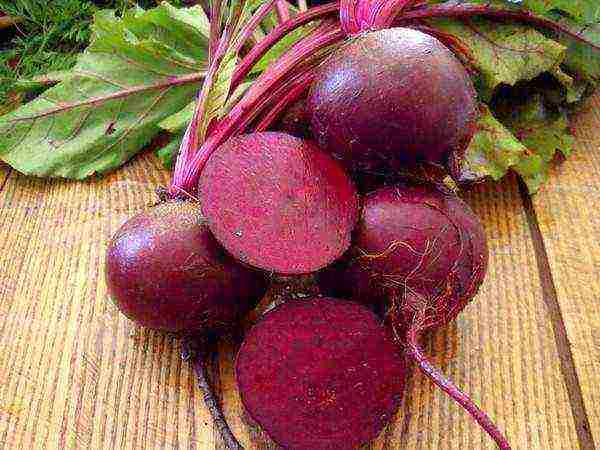
The root crop is stored without losing its shape and taste for several months, it is not prone to cracking, shooting and flowering, it is resistant to many dangerous diseases (scab, cercospora, corneed). Pablo F1 beets have a straight, medium-sized rosette, round-shaped fruits, weighing 100-150 grams (sometimes up to 200-250 grams), 10-15 cm in diameter, average yield - up to 7 kg per "square". The color of the pulp is burgundy-purple, the skin of the root crops is burgundy, smooth, rather thin. The growing season is 100-110 days.
Beet Cylinder
Another very popular, time-testedbeet variety - Cylinder... Gardeners fell in love with it for a rather long shelf life (more than 4 months), sweet juicy pulp without the notorious rings, very tasty, as well as resistance to major diseases of root crops.
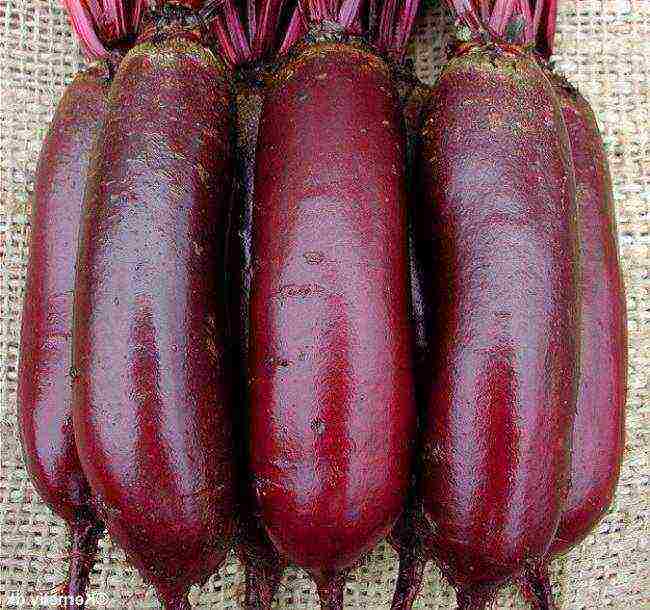
The Cylinder beet variety belongs to the middle late (ripening period - from 120 to 130 days). The shape of the fruit is elongated, cylindrical, diameter - 5-8 cm, length - 10-15 cm. Fruits are medium-sized, with dark skin, weighing 150-250 grams (sometimes more). Cylinder beets are often grown for sales because the roots grow neat, even, and even. Productivity - more than 7 kg per "square", and the "cylinders" are pulled out of the ground very easily.
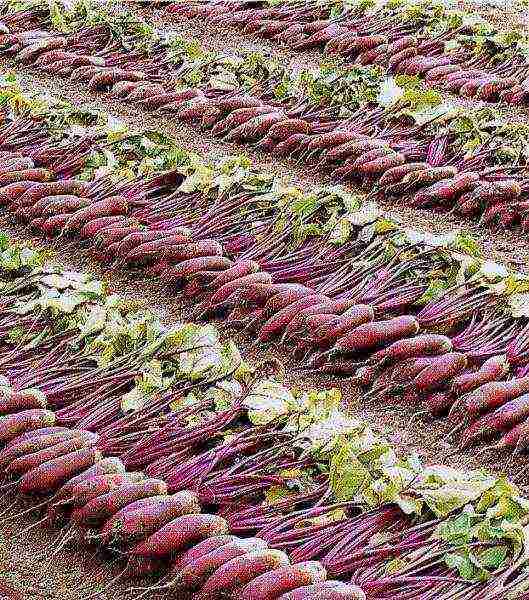
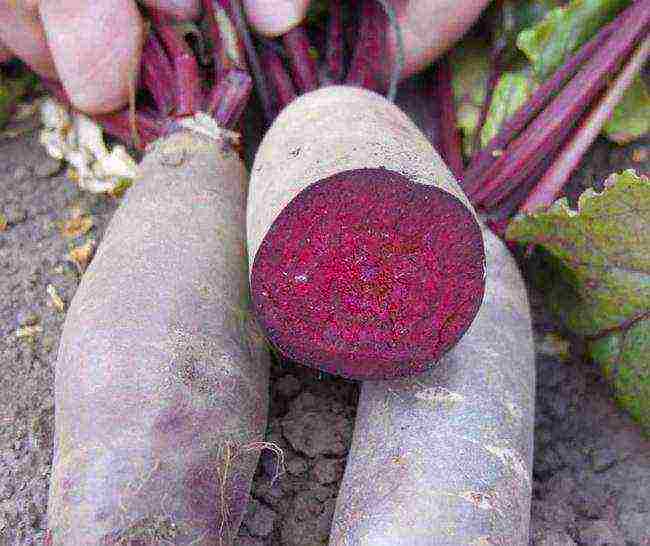
Also in favor of the Cylinder beet is the fact that improved hybrids were developed on its basis - Daughter F1 cylinders and Granddaughter F1.
Beet mulatto
This is a mid-season beet variety (110-120 days), which appeared on store shelves not so long ago, but is already loved by gardeners. The beet variety Mulatto is not very rich in color of the pulp (not burgundy or ruby, namely dark red), but this in no way affects the richness of the taste - it is juicy, sweet, very tasty. After heat treatment, it does not change color, which is important for borscht lovers. Root crops are round, not too large (150-300 grams), smooth. 4-5 kg of mulatto beets are harvested from one "square" of the garden. This variety is suitable for winter storage, resistant to temperature fluctuations, unpretentious to soil, immune to flower beds. Among the disadvantages of beetroot Mulatto is increased demand for lighting; in the shade, the root crop will grow savory and small.
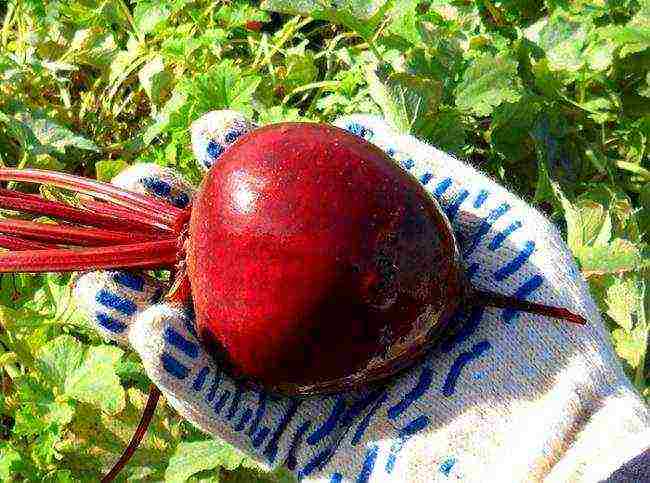
Egyptian flat beet
Bred almost 80 years ago, this beet variety is still popular today, which says a lot. Of course, Egyptian flat beets are not as sweet and tasty as some new varieties (in other words, they taste as usual), they will not last until summer (although 70-80% of root crops will survive the winter), and even to Cercospora, the main enemy of beets, this variety weakly stable. But the Egyptian flat beet also has advantages, thanks to which it still remains among the leaders in the preferences of summer residents: unpretentiousness to soils, the ability to tolerate long periods of drought without damage, and resistance to flowering.
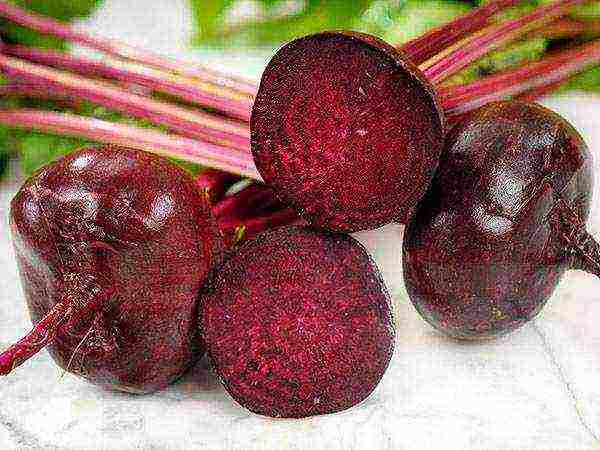
The characteristics of the Egyptian flat beet variety are as follows: the ripening period is 90-100 days (medium early), the root crop grows flattened, small, neat, the average weight is 200-350 grams, but there are specimens up to 500 grams, 4- 8 kg of root crops; the color of the pulp is burgundy-purple, without pronounced rings.
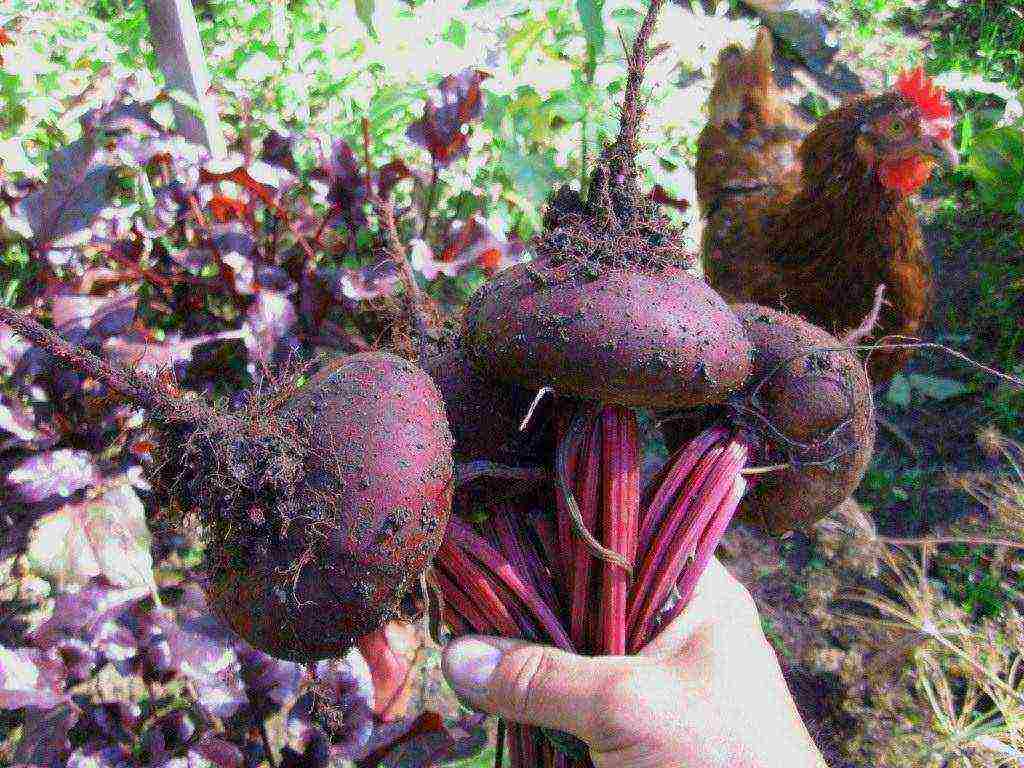
Bordeaux beet 237
Beet variety Bordeaux 237 - another time-tested, reliable, and for many summer residents - the best variety of red beets. Rounded, neat root vegetables with rich burgundy juicy sweet pulp are not too large, so they are convenient to process, bake, Bordov 237 is well suited for salads. The variety is famous for its stable yield, good germination, heat and drought resistance and the ability to store well - until spring, or even until the new season, will lie in the cellar without frowning or shrinking.
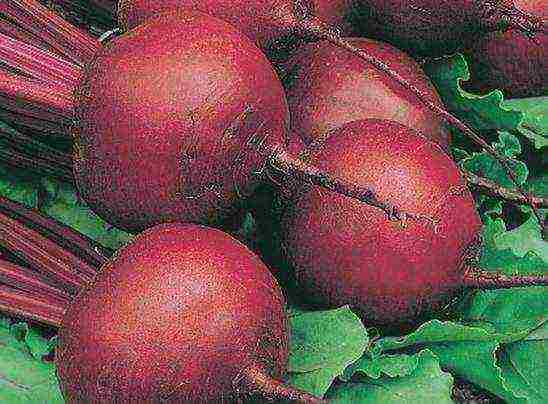
Bordeaux 237 beets are medium early (ripening period - 70-110 days), root crops grow weighing from 200 to 500 grams, with a diameter of 10-15 cm, the shape is round or slightly flattened. The variety is considered resistant to diseases, but in some years it is affected by peronosporosis and cercosporosis. From the "square" of the garden, you can collect from 4 to 8 kg of beets.
Detroit beet
Perhaps the most popular of the early-growing beet varieties today. Still - during the season Detroit can be sown twice, since the ripening period of the root crop is only 650-100 days. Taste qualities beetroot detroit gorgeous - it is juicy, dark red, has a pleasant sweet taste. Root crops grow small (from 100 to 200 grams), but aligned, round, smooth, with a very small axial root - in general, very marketable. Among other advantages of Detroit beets - resistance to bloom, to cold.

As for early beets, Detroit is stored well, but for laying for long winter storage, it is still better to choose another variety, mid- or late-ripening. Another unpleasant bonus of this early maturing beet is its weak resistance to diseases, increased demand for watering and light.
Beetroot red ball
It is an early variety with a ripening period of 65-100 days, which is famous for its very juicy, dark red, almost purple sweet flesh, practically without rings on the cut. It is recommended for use in dietary and baby food, and, of course, in cooking (it cooks quickly, but does not have an unpleasant "beetroot" aftertaste). Beet variety Red ball is resistant to cold weather, flowering, stemming, drought and disease resistance - medium. Root crops grow round, weighing 200-500 grams. Productivity of beets Red ball is high, up to 6 kg of root crops are harvested from the "square" of the garden. Stored without problems until spring.

Beet Mona
The mid-late representative of the beet is cylindrical, so in the middle lane it may not have time to ripen. Beet variety Mona good because it is one-sprout (not 3-5 sprouts grow from one seed, but only one), so thinning is not required. As a result, root crops form quickly, grow even and delight with a stable yield. Despite its elongated shape, this beet is easily pulled out of the ground, as it will plunge into the soil only a third of its length. The average weight of Mona beets is 200-350 grams, length is 10-20 cm, diameter is about 5 cm, pulp is tender, juicy, dark red, rings are almost invisible. The yield is high - 6-7 kg of root crops from the "square" of the garden.
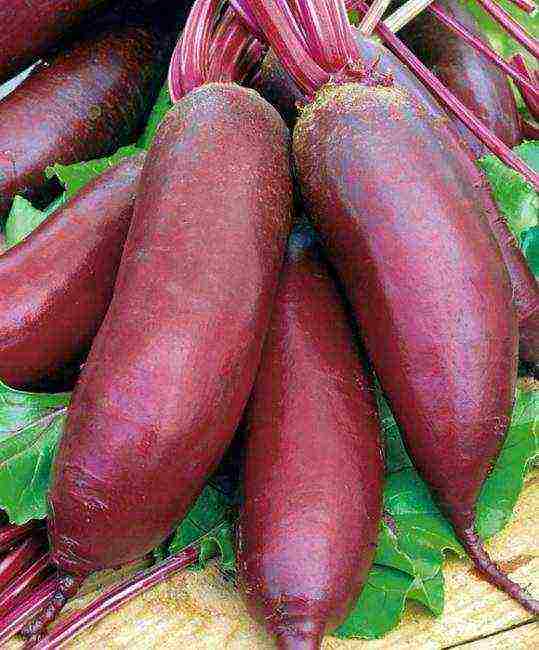
Beet Incomparable
This beet got its name for its excellent taste - its pulp is juicy, very sweet, dark red with almost black rings. Beet variety Incomparable refers to early maturing (70-96 days). Root crops grow round or slightly flattened, weighing 150-400 grams, are stored, despite early maturity, well - until spring. Of the features - incomparable beets do not like heavy soils, are weakly resistant to cercosporosis, resistant to flowering, stemming and cold weather.
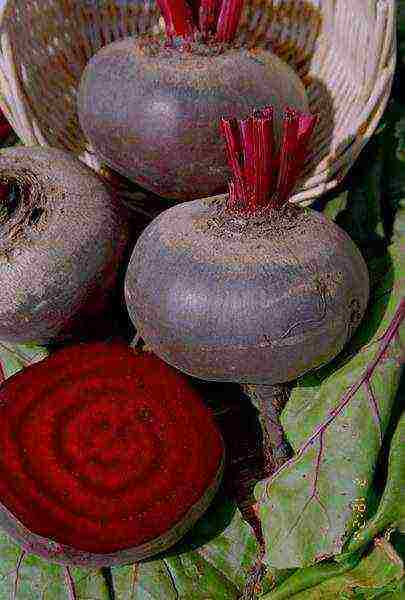
Boltardi beet
An early maturing variety (70-100 days), which, due to its cold resistance, can be sown very early in the open field. Roots beetroot boltardi grow medium-sized (150-350 grams), but very even, smooth, neat rounded shape. The pulp deserves special attention: it is completely ringless, burgundy-purple, very sugary and juicy. Suitable for bookmarking for long-term storage. Boltardi beets are considered resistant to diseases and flowering, but demanding on watering and feeding. From the "square" of the garden, you can collect 3-8 kg of root crops.
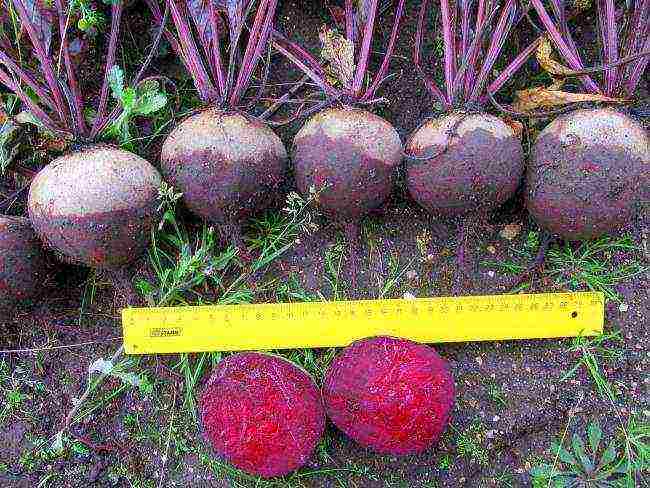
Beetroot bovine blood
This beet variety is for lovers of large root crops: the weight of one specimen can exceed 600 grams. Beetroot bovine blood - a medium late variety (110-120), distinguished by resistance to cold weather, flowering and excellent keeping quality. The beet pulp is dark red, with slightly pronounced rings, but without hard veins; after cooking, the color does not change. In the characteristics of the beet variety, it is indicated that the weight of root crops is 150-240 grams, but in fact, gardeners note that the real weight of Bovine blood is 2 or even three times higher.
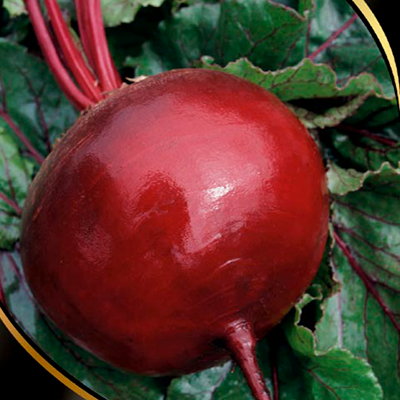
Bona beet
This is a relatively new variety of beets with medium ripening periods (105-120 days), which summer residents fell in love with for their juicy, delicate, sweet pulp taste, small uniform rounded root crops weighing 200-300 grams and good keeping quality. Beet variety Bona pleasant in that it has no rings on the cut and is resistant to most diseases. You can collect 5-7 kg of root crops from the "square" of the garden.
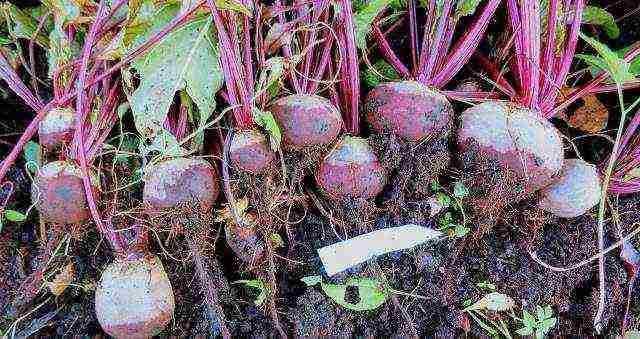
Beetroot
Popularity beet variety Smuglyanka due to its sweet, rich taste, dense pulp of bright pink-purple color and very good keeping quality. Smuglyanka beet belongs to mid-season varieties (95-110 days), root crops grow up to 200-400 grams in weight. Among other advantages of the variety are the stability of yields, cold resistance, resistance to flowering.
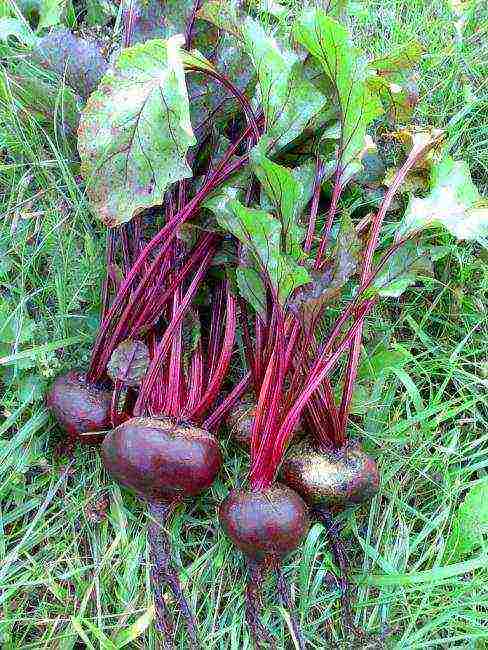
Podzimnyaya beet A 474
From the name it is obvious that this is one of the best varieties of beets for winter sowing. Overall beets Podzimnyaya A 474 is a mid-season variety (95-105 days), and is suitable not only for winter sowing, but also for early spring. Differs in dark red flat-rounded roots, growing up to 200-300 grams. Podzimnyaya beet pulp A 474 is sweet, juicy, with a good taste and dark red color. Equally important features of the variety are cold resistance and suitability for long-term storage.

Beet Kestrel F1
One of the main canteen beetroot hybrids for Europe and the USA. Moreover: abroad Kestrel F1 is one of the quality standards and high yield. It is used in baby food and juices, as the rich red color does not "fade" after heat treatment. Same beet hybrid Kestrel F1 possesses excellent commercial qualities - uniformity of root crops, good transportability, high sugar content, keeping quality.
Beet Kestrel F1 belongs to mid-season hybrids (90-100 days) with a small root process, a smooth surface, a small leaf rosette. The average fruit weight is from 300 to 400 grams.
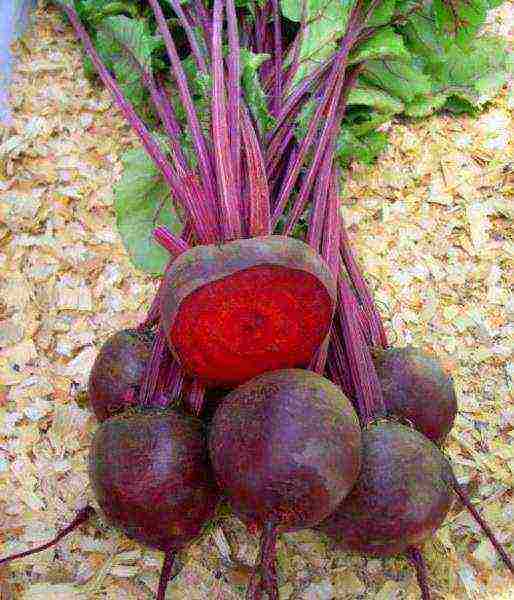
Of course, these are not all the best varieties of table beet. From the early one can be distinguished Odnorostkovaya, Libero, Vinaigrette Marmalade, Gribovskaya flat, Crimson, Borshchevaya, Kubanskaya; from mid-season - Bohemia, Negritanka, Tenderness, Opolskaya, Bon-Bon, Larka; from the later ones - Ataman, Torpedo, Renova. This is not to mention hybrids, of which a lot has appeared recently!

